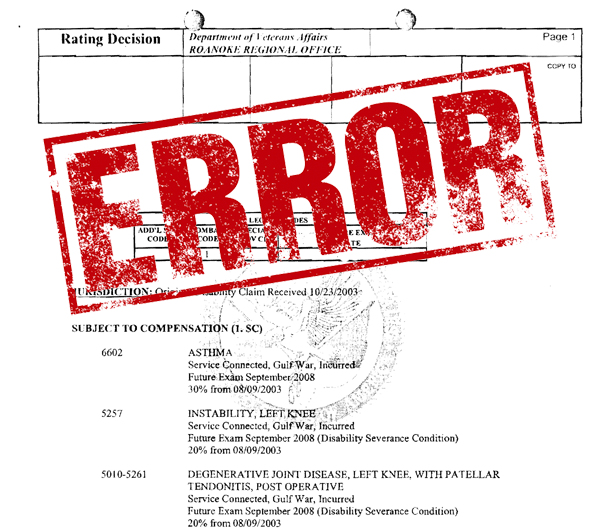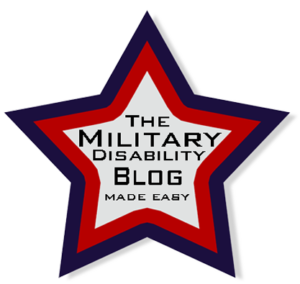Clear and Unmistakable Error (CUE)
- Published:
- Last Updated: March 20, 2023

Do you feel like the VA made an obvious error on your case and you want to know the best way to get it fixed?
You may have heard about CUEs: Clear and Unmistakable Errors.
The error on your case may seem pretty clear and unmistakable to you, but does it truly meet the qualifications for a Clear and Unmistakable Error, and if so, what can you do about it?
Let’s discuss exactly what a Clear and Unmistakable Error is, the best options to get a CUE fixed, and the things you need to do to file a CUE claim.
What is a CUE?
A Clear and Unmistakable Error (CUE) is an error made by the VA on a claim decision that clearly goes against stated policy, regulations, or legal precedents.
In order to be considered a Clear and Unmistakable Error, your case must meet all three of these requirements:
- The adjudicator overlooked evidence that was definitely included as part of the claim, or they incorrectly applied the regulations/legal standards in effect at the time.
- If the error had not been made, the outcome of the claim would definitely have been different.
- The error was made on the evidence and regulations in play at that time.
A Clear and Unmistakable Error is very specific. A clear, undisputable mistake.
An error is not a Clear and Unmistakable Error if:
- it is based on an aspect of the system that is left up to interpretation
- there was evidence missing from the original claim (like insufficient examinations)
- the evidence or regulations changed after the decision was made
- the outcome of the claim would not have been different
- etc.
A CUE must be so obvious that “reasonable minds could not differ” (38 CFR) when presented with the facts of the case. Got it?
If it now is clear that the error made on your claim is not actually a Clear and Unmistakable Error, then your best option is to simply pursue correcting it through the standard VA Appeals process.
If, however, the error is definitely a Clear and Unmistakable Error, you’ll need to decide whether to file a CUE Claim or stick to the Appeals system.
Do I file a CUE Claim or just an appeal?
A CUE Claim isn’t actually a claim at all, but a motion to revise the flawed decision.
Requesting a revision of your decision based on a Clear and Unmistakable Error is very difficult and requires that your argument be undeniable. Because of this, it is best to only request a CUE revision when other avenues are no longer open to you.
The easiest way to resolve a Clear and Unmistakable Error is to simply apply for a Higher Level Review. This alone will resolve the vast majority of Clear and Unmistakable Error cases.
A Higher Level Review is one of the three VA Appeal lanes (Higher Level Review, Supplemental Claim, and the Board of Veterans’ Appeals). You can request a Higher Level Review within 1 year of the date of the decision when the error was made.
When you apply for a Higher Level Review, a higher authority will review every aspect of your original claim along with all of the evidence you originally submitted with it.
Since a Clear and Unmistakable Error must be so obvious that “reasonable minds could not differ,” this in-depth review alone should be enough to correct the CUE. If the Clear and Unmistakable Error is not resolved at this stage, then that means the error is unlikely to actually be a CUE and your best option will be to pursue other paths within the Appeals system.
So when do you submit a CUE Claim?
There is no limit on when you can file a CUE Claim. You can request a revision based on a Clear and Unmistakable Error at any time for any decision, even if the decision has already been finalized.
That being said, you cannot request a CUE revision if the decision has already been reviewed in-depth by a second party, like a Higher Level Review or the Board of Veterans Appeals (BVA). If those authorities did not fix the error at that time, then they are essentially affirming that a Clear and Unmistakable Error was not made on the decision.
Since a Higher Level Review is still the best way to go to resolve a CUE, this means the only times you should request a CUE revision are when you miss the deadline to request a Higher Level Review or appeal to the BVA, or when the higher review authority makes a new CUE in their decision that was not made in the original decision.
Essentially, if a higher authority (like the BVA) reviews the decision with the CUE and decides that there was no error, then the CUE is permanently ruled out. You can’t request a CUE revision when the evidence indicates that a CUE does not exist. You can only continue with a reconsideration by the BVA or higher level of appeal.
If, however, the higher authority makes a new CUE on their decision when there was not a CUE before, then you can request a CUE revision for the new error. In this case, though, it is still better to simply request a reconsideration if you are within the required timeframe.
How do I file a CUE Claim?
To request a revision of a decision because of a Clear and Unmistakable Error, you must submit a signed letter that gives thorough particulars of the error. The letter must include the following in detail:
- The specific error
- The exact facts, laws, or evidence the error violated
- How the outcome would have been different had the error not been made
In order for your CUE claim to be successful, you must be very specific and detailed in this letter. Make sure to clearly reference the exact laws or regulations that are pertinent to the case and provide explicit directions to the evidence necessary to prove the Clear and Unmistakable Error. Do not leave anything up to interpretation, but be specific, thorough, and clear.
Do not include any new evidence with your letter. You cannot submit new evidence with a CUE Claim. In order for the error to be a Clear and Unmistakable Error, it must have been made based only on the laws and evidence in play at the time of the original decision.
If you are filing a CUE Claim for a decision from a Regional Office, then you should mail the letter directly to that office.
If you are filing for a decision from the BVA, then you should mail it to:
Litigation Support Branch
Board of Veterans’ Appeals
P.O. Box 27063
Washington, DC 20038
After you file a CUE Claim
If your CUE Claim is successful, then the VA will correct the error made on the decision and any subsequent decisions affected by the error.
You will then receive all the benefits based on the corrected decision starting from the date of the original decision. So, if the correction means that you should have been paid an additional $50/month for the past 12 months, then you will receive $600 of Back Pay.
If the Clear and Unmistakable Error is denied, then the VA attests that there is enough doubt in the case that it is not “clear and unmistakable.” At this point, you cannot request another CUE review for this issue. It is not a clear and unmistakable error. The only options left to you are to appeal the original decision based on the rules of the various appeals options.
What if the VA discovers the CUE?
The VA can discover Clear and Unmistakable Errors in your case without you filing for a review. When this happens, the VA will correct the error and update your benefits accordingly.
If the error was in your favor (you were rated higher than you should have been, etc.), then the VA could require that you repay any benefits that you received.
The VA cannot, however, lower a rating that has been in effect for 20 years or more or reverse a service-connection decision that has been in effect for 10 years or more.
Recent Posts
TDRL vs. PDRL—Which is better for disability benefits?
Leukemias and Multiple Myelomas NOW on the Presumptive List
Two MORE Conditions added to the Burn Pit Presumptive List
The 2025 VA Disability Rates are here!
About Us









